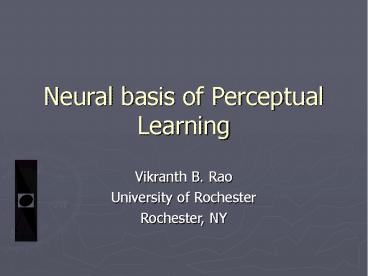Neural basis of Perceptual Learning PowerPoint PPT Presentation
Title: Neural basis of Perceptual Learning
1
Neural basis of Perceptual Learning
- Vikranth B. Rao
- University of Rochester
- Rochester, NY
2
Research Group
Alexandre Pouget Jeff Beck Wei-ji Ma
3
Perceptual Learning in Orientation Discrimination
- Orientation discrimination is subject to
learning. - Perceptual Learning (PL) is one such form of
learning. - Repeated exposure leads to decrease in
discrimination thresholds (Gilbert 1994).
4
Central Question
- Perceptual learning is a robust phenomenon in a
wide variety of perceptual tasks. - When applied to orientation discrimination, how
do we relate the learned improvement in
behavioral performance, to changes in population
activity due to learning at the network level? - This is the question we aim to answer.
5
Approach
- We assume behavioral improvements are due to
information increases in sensory representations. - (Paradiso 1998, Geisler 1989, Pouget and Thorpe
1991, Seung and Sompolisky 1993, Lee et al. 1999,
Schoups et al. 2001 Adini et al. 2002, Teich and
Qian 2003). - By information, we mean Fisher Information
- It clearly relates to discrimination thresholds
- It can be directly computed from first and
second-order statistics (mean and variance). - It can be computed for a population of neurons.
6
Fisher Information
- By information, we mean the information about the
stimulus feature (orientation ?), in a pop. of
neurons. - Response of one neuron in the pop. can be written
as - The Fisher Information for this neuron is
(Seung and Sompolinsky, 1993)
- For a population of neurons with independent
noise
7
Problems
- We know that neurons are not independent.
- Mechanisms which
- Change tuning curves may also change the
correlation structure - Change correlation structure may also change
tuning curves - Change cross-correlations but not single-neuron
statistics can increase information drastically
(Series et. al. 2004)
8
Investigative Approach
- We want to use networks of biologically plausible
spiking neurons with realistic correlated noise
to study the neural basis of PL. - Therefore, we consider
- Two spiking neuron network models
- Linear Non-Linear Poisson (LNP) neurons
analytically tractable but less biologically
realistic - Conductance-based integrate and fire (CBIF)
neurons biologically very realistic but
analytically intractable - Biologically plausible connectivity
- Biologically plausible single-neuron statistics
(near unit Fano factor) - Enough simulations to produce a reasonable lower
bound on Fisher information
9
Exploring candidate mechanism(s) for PL
- We want to investigate changes in Fisher
Information as a result of the following
manipulations to network dynamics - Sharpening
- Via feed-forward connectivity
- Via recurrent connectivity
- Amplification
- Via feed-forward connections
- Via recurrent connections
- Increasing the number of neurons
- We use the analytically tractable LNP network to
generate predictions and the CBIF network to
confirm these predictions
10
Sharpening LNP Simulations
40
Activity spikes/s
20
0
-45
0
45
Orientation (deg)
40
Activity spikes/s
20
0
-45
0
45
Orientation (deg)
11
Results - Sharpening
- Sharpening by adjusting feed-forward
thalamocortical connections
12
Results - Sharpening
- Sharpening by adjusting recurrent lateral
connections
13
Comparing sharpening schemes
14
Future Work
- Exploring changes in Fisher information as a
result of - Amplification
- Increasing the number of neurons
- Exploring other ways of increasing information
- Exploring Early versus Late theories of Visual
Learning
15
Conclusion
- We are interested in investigating the changes at
the population level, that sub-serve the
improvement in behavioral performance seen in PL. - We follow the prevalent view that improvement in
behavioral performance is due to information
increase in the population code. - Relaxing the independence assumption no longer
allows us to relate changes at the single-cell
level to changes at the population level, in
terms of information throughput. - An exploration of the mechanism of sharpening at
the population level, using networks of spiking
neurons with realistic correlated noise, yields
the following results - Sharpening through an increase in feed-forward
connections leads to an increase in information
throughput - Sharpening by changing the recurrent lateral
connections leads to a decrease in information
throughput

